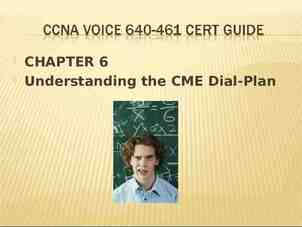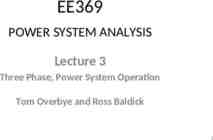CEMENT CONCRETE MIX DESIGN Prepaid by: 130670106041 130670106042 1
54 Slides2.88 MB

CEMENT CONCRETE MIX DESIGN Prepaid by: 130670106041 130670106042 1

Cement Concrete Mix Design means, determination of the proportion of the concrete ingredients i.e. Cement, Water, Fine Aggregate,Coarse Aggregate which would produce concrete possessing specified properties such as workability, strength and durability with maximum overall economy. 2

Methods of Concrete Mix Design I.S. Method British Method A.C.I. Method etc. 3

These Methods are based on two basic assumptions Compressive Strength of Concrete is governed by its Water-Cement Ratio Workability of Concrete is governed by its Water Content 4

Data required for concrete mix design 1. 2. 3. 4. 5. Grade of Concrete Eg: RCC-M30-A20 Slump required in mm Eg: 25 – 75 mm Degree of Site Control Eg: Good Type of Exposure Eg: Moderate Grade of Cement Eg: OPC 43 Grade 5

Placing Conditions Degree of Workability Slump (mm) 1 2 3 Very Low See 7.1.1 Mass Concrete; Lightly reinforced sections in Slabs, Beams, Walls, Columns; Floors; Hand placed Pavements; Canal lining; Strip Footings Low 25-75 Heavily reinforced sections in Slabs, Beams, Walls, Columns; Slip form work; Pumped Concrete. Medium 50-100 Blinding Concrete; Shallow Sections; Pavements using pavers Trench fill; In-Situ Piling; Tremie Concrete High 100-150 6

Site control having proper storage of cement; weigh batching of all materials; Controlled addition of water, regular checking of all materials, Good aggregate grading and moisture content; And periodical checking of workability and strength. Fair Site control having deviation from the above. 7

Sl. No. Environment Exposure Conditions 1 2 3 i) ii) iii) iv) v) Mild Concrete surfaces protected against weather or aggressive conditions, except those situated in coastal area. Moderate Concrete surfaces sheltered from severe rain or freezing whilst wet. Concrete exposed to condensation and rain. Concrete continuously under water. Concrete in contact or buried under non-aggressive soil/ground water. Concrete surfaces sheltered from saturated salt air in coastal area. Severe Concrete surfaces exposed to severe rain, alternate wetting and drying or occasional freezing whilst wet or severe condensation. Concrete completely immersed in sea water. Concrete exposed to coastal environment. Very Severe Concrete exposed to sea water spray, corrosive fumes or severe freezing conditions whilst wet. Concrete in contact with or buried under aggressive sub-soil/ground water. Extreme Surface of members in tidal zone. Members in direct contact with liquid/solid aggressive 8 chemicals.

Approximate Quantity of Materials required for concrete mix design 1. 2. 3. Cement : 200 Kg. Fine Aggregate : 240 Kg. Coarse Aggregate : 180 Kg. (20 mm) 180 Kg. (10 mm) 9

STEPS INVOLVED IN CONCRETE MIX DESIGN Step I:- Determine the physical properties of concrete ingredients. I. CEMENT (OPC 43 Grade) Sl. No. 1 2 3 4 5 Particulars of Test Standard consistency (% by weight) Setting Time in minutes a) Initial b) Final Compressive Strength in N/sq.mm at the age of a) 3 days b) 7 days c) 28 days Specific Gravity Fineness in Sq.m/Kg Result Specifications As per IS:8112-1976 25.6 95 210 30 Minimum 600 Maximum 24 35 46 3.00 337 23 Minimum 33 Minimum 43 Minimum 225 Minimum 10

II. FINE AGGREGATE 1. Sieve Analysis Sieve Size % Passing Specifications for Zone–II As per IS:383-1970 10.0 mm 100 100 4.75 mm 100 90-100 2.36 mm 98 75-100 1.18 mm 65 55-90 600 micron 42 35-59 300 micron 8 8-30 150 micron 0 0-10 2. Specific Gravity : 2.60 3. Unit Weight in Kg/Cu.m a) Loose b) Rodded : : 1460 1580 : 1.00 4. Materials Finer than 75 micron Max (% by weight) 3 11

III. 20.0mm COARSE AGGREGATE 1. Sieve Analysis Sieve Size 40.00mm 20.00mm 10.00mm 4.75mm % Passing 100 90 3 0 Specifications As per IS:383-1970 Graded 100 95-100 25-55 0-10 Single Sized 100 85-100 0-20 0-5 2. Specific Gravity : 2.65 3. Unit Weight in Kg/Cu.m a) Loose b) Rodded : : 1467 1633 12

IV. MECHANICAL PROPERTIES Sl. No. 1 Particulars of Test Result Crushing Value in % 28 2 Impact Value in % 24 3 Los Angeles Abrasion Value in % 30 Specifications As per IS: 383-1970 30 Maximum For wearing surfaces 45 Maximum For other concrete 30 Maximum For wearing surfaces 45 Maximum For other concrete 30 Maximum For wearing surfaces 50 Maximum For other concrete 13

V. 10.0mm COARSE AGGREGATE 1. Sieve Analysis Sieve Size % Passing Specifications As per IS:383-1970 Graded Single Sized 12.50mm 100 – 100 10.00mm 85 – 85-100 4.75mm 19 – 0-20 2.36mm 0 – 0-5 2. Unit Weight in Kg/Cu.m a) Loose b) Rodded : : 1427 1587 14

VI. BLENDING OF COARSE AGGREGATE: Sieve size (mm) IS:383-1970 Specifications (Graded) % Passing 20 mm 10 mm 60% 40% 50% 50% 40 100 100 100 100 100 20 95-100 90 100 94 95 10 25-55 3 85 40 44 4.75 0-10 0 19 7 10 15

Step II:Strength: Compute Target Mean Compressive Fck fck t * S Fck Target Mean Compressive Strength at 28 days in N/Sq.mm fck in Characteristic Compressive Strength at 28 days N/Sq.mm S Standard Deviation in N/Sq.mm t of A Statistic, depending on accepeted proportion low results. 1.65 for 1 in 20 accepted proportion of low results 16

Values of Accepted proportion of low results t t 1 in 5, 20% 0.84 1 in 10, 10% 1.28 1 in 15, 6.7% 1.50 1 in 20, 5% 1.65 1in 40, 2.5% 1.86 1 in 100, 1% 2.33 17

Assumed Standard Deviation (Table 8, IS:456-2000) Grade of Concrete Assumed Standard Deviation (N/Sq.mm) Good Site Control Fair Site Control M10, M15 3.5 4.5 M20, M25 4.0 5.0 M30, M35 M,40,M45 M50 5.0 6.0 18

Step III:- Select the Water-Cement ratio of trial mix from experience S. No. Concrete Grade Minimum expected W/C 1 M10 0.9 2 M15 0.7 3 M20 0.55 4 M25 0.50 5 M30 0.45 6 M35 0.40 7 M40 0.35 8 M45 0.30 19

Step IV:- Select the water content per cubic metre of concrete from table2 of I.S: 10262-2009. Maximum size of Aggregate (mm) Water Content per cubic metre of concrete (Kg) 10 208 20 186 40 165 20

Approximate water content (Kg) per cubic metre of concrete (Table 32, SP:23-1982) Slump (mm) Maximum Size of Aggregate (mm) 10 20 40 30-50 205 185 160 80-100 225 200 175 150-180 240 210 185 21

Volume of Coarse Aggregate per Unit Volume of Total Aggregate (Table 3, IS:10262-2009) Volume of Coarse Aggregate per Unit Volume of Total Aggregate Maximum Size of Zone IV Zone III Zone II Zone I Aggregate (mm) 10 0.50 0.48 0.46 0.44 20 0.66 0.64 0.62 0.60 40 0.75 0.73 0.71 0.69 22

23

Step V:- Compute the quantity of cement as follows. Water Cement ------------W/C Ratio 185 / 0.45 411 Kg. 24

Step VI:- Then we find the quantities of Fine & Coarse aggregate by absolute volume method. V (W C/Sc (1/p) * (fa/Sfa)) * (1/1000) and V (W C/Sc (1/(1-p)) * (ca/Sca)) * (1/1000) - (Eq.1) - (Eq.2) Where V Absolute volume of fresh concrete 1 m3 W Mass of Water (Kg) per m3 of concrete C Mass of Cement (Kg) per m3 of concrete p Percentage of fine aggregate. fa Mass of fine aggregate ca Mass of coarse aggregate Sc Specific gravity of cement. Sfa Specific gravity of fine aggregate. Sca Specific gravity of coarse aggregate. 25

Substituting the values in Eq(1), we get 1000 185 411/3.0 (1/0.36) * fa /2.6) 185 137 fa/0.936 322 fa/0.936 fa (1000 – 322) * 0.936 678 * 0.936 635 Kg. 26

Substituting the values in Eq(2), we get 1000 185 411/3.0 (1/0.64) * ca /2.65) 185 137 ca/1.696 322 ca/1.696 ca (1000 – 322) * 1.696 678 * 1.696 1150 Kg. 27

So the mix proportion works out to be W : C : fa : ca 185 : 411 : 635 : 1150 0.45 : 1 : 1.55 : 2.80 This mix will be considered as Trial Mix No.2 28

Step VII:- Make slump trials to find out the actual weight of water to get required slump. Make corrections to the water content & %FA, if required. Step VIII:- Compute 2 more trial mixes with W/C ratios as 0.40 & 0.50, taking %FA as 34% and 38% respectively. 29

Trial Mix No. 1:Cement 185 / 0.4 462.5 Kg. Substituting the values in Eq(1), we get 1000 185 462.5/3.0 (1/0.34) * fa /2.6) fa 584 Kg. Substituting the values in Eq(2), we get 1000 185 462.5/3.0 (1/0.66) * ca /2.65) ca 1156 Kg. So the mix proportion works out to be W : C : fa : ca 185 : 462.5 : 584 : 1156 0.4 : 1 : 1.26 : 2.50 30

Trial Mix No. 3:Cement 185 / 0.5 370 Kg. Substituting the values in Eq(1), we get 1000 185 370/3.0 (1/0.38) * fa /2.6) fa 683 Kg. Substituting the values in Eq(2), we get 1000 185 370/3.0 (1/0.62) * ca /2.65) ca 1136 Kg. So the mix proportion works out to be W : C : fa : ca 185 : 370 : 683 : 1136 0.5 : 1 : 1.85 : 3.07 31

Step IX:- Cast atleast 3 cubes for each trial mix. Step X:- Test the cubes for compressive strength at 28 days. 32

28 Days Compressive Strengths of Trial Mixes W/C Ratio C/W Ratio Compressive Strength (Kg/Cm2) 0.40 2.50 457 0.45 2.22 420 0.50 2.00 360 33

Step XI:- Draw a graph between compressive strength Vs C/W Ratio. 34

35

Step XII:- From the graph, find the W/C ratio for the required target mean compressive strength. Step XIII:- Calculate the mix proportions corresponding to the W/C ratio, obtained from the graph. 36

Final Mix:From the graph, for a target strength of 390 Kg/Cm2, W/C ratio 0.47 Cement 185 / 0.47 394 Kg. Substituting the values in Eq(1), we get 1000 185 394/3.0 (1/0.38) * fa /2.6) fa 675 Kg. Substituting the values in Eq(2), we get 1000 185 394/3.0 (1/0.62) * ca /2.65) ca 1123 Kg. So the mix proportion works out to be W : C : fa : ca 185 : 394 : 675 : 1123 0.47 : 1 : 1.71 : 2.85 37

Step XIV:- Check the cement content & W/C ratio against the limiting values given in Table-5 of I.S: 456-2000 for given type of exposure & type of Concrete. 38

Table-5 Minimum Cement content Maximum Water-Cement ratio and Minimum Grade of Concrete for different exposures with normal weight of aggregate of 20mm nominal maximum size. Plain Concrete Sl. No. Exposure Reinforced Concrete Minimum Cement Content kg/m3 Maximum Free Water Cement Ratio Minimum Grade of Concrete Minimum Cement Content kg/m3 Maximum Free Water Cement Ratio Minimum Grade of Concrete i) Mild 220 0.60 - 300 0.55 M20 ii) Moderate 240 0.60 M15 300 0.50 M25 iii) Severe 250 0.50 M20 320 0.45 M30 iv) Very Severe 260 0.45 M20 340 0.45 M35 v) Extreme 280 0.40 M25 360 0.40 M40 39

From the table 5 of IS: 456–2000, the minimum Cement content & W/C ratio, For moderate, for RCC are 300Kgs. & 0.5 The Cement content 394Kgs. 300Kgs. Hence Ok The W/C Ratio 0.47 0.5 Hence Ok 40

TEST REPORT Concrete Mix RCC M30 with 20.0mm M.S.A. Sl. No. Particulars Result 1 Characteristic Compressive strength in N/Sq.mm 30 2 Maximum size of Aggregate in mm 3 Type of Exposure 4 Type of Site control Good 5 Target Average Compressive Strength in N/Sq.mm 38.2 6 Workability in terms of Slump in mm 7 Mode of Compaction 8 Mix Partiuclars: a. Water-Cement Ratio b. Materials per cubic metre of concrete in Kg. i) Water ii) Cement (OPC 43 Grade) iii) Fine Aggregate iv) Coarse Aggregate c. Mix Portion by weight 20.0 Moderate 25-75 Vibration 0.47 185 394 675 1123 1:1.71:2.85 41

Secondary Slides: 42

Sieve Analysis of Fine Aggregate Weight of sample 500g (approx) Observations: Sieve size Weight retained(g) % Cumulative weight retained (g) % Passing IS:383-1970 Specifications Zone II Trail 1 Trail2 Total Cumulative weight retained (g) 10 mm 0 0 0 0 0 100 100 4.75 mm 2 2 4 4 0 100 90-100 2.36 mm 6 7 13 17 2 98 75-100 1.18 mm 166 165 331 348 35 65 55-90 600 micron 118 117 235 583 58 42 35-59 300 micron 175 160 335 918 92 8 8-30 150 micron 36 42 78 996 100 0 0-10 150 micron pass 2 2 4 - - - - 43

Zones of Fine Aggregate IS : 383 – 1970 Sieve Size % Passing for Zone I Zone II Zone III Zone IV 10.00 mm 100 100 100 100 4.75 mm 90-100 90-100 90-100 95-100 2.36 mm 60-95 75-100 85-100 95-100 1.18 mm 30-70 55-90 75-100 90-100 600 micron 15-34 35-59 60-79 80-100 5-20 8-30 12-40 15-50 0-10 0-10 0-10 0-15 300 micron 150 micron 44

Sieve Analysis of Coarse Aggregate 2 20 mm aggregate : a. Minimum weight of sample 25 Kg b. Observations : Weight retained (Kg) Cumulative weight retained (Kg) % Cumulative weight retained (Kg) 40 0.0 0.0 0 20 4.7 4.7 10 41.5 4.75 1.6 4.75 P 0 Sieve size IS:383-1970 Specifications % Passing Graded Single sized 100 100 100 10 90 95-100 85-100 97 3 25-55 0-20 47.8 100 0 0-10 0-5 47.8 - - - - 46.2 45

Sieve Analysis of Coarse Aggregate 2 10 mm aggregate : a. Minimum weight of sample 12 Kg b. Observations : IS:383-1970 Specifications Weight retained (Kg) Cumulative weight retained (Kg) % Cumulative weight retained (Kg) 12.5 0.0 0.0 0 100 100 10 5.4 5.4 15 85 85-100 4.75 24.3 81 19 0-20 2.36 6.9 36.6 100 0 0-5 2.36 P 0 36.6 - - - Sieve size 29.7 % Passing Single Sized - 46

Target mean compressive strength N 20 N 20 Avg 30 Avg 35 27,30,30,32,35, 27,33,34,29,28, 30,28,31,32,26, 34,33,25,27,29 28, 32,35,38,40, 34,35,35,36,39, 33,32,32,34,37, 32,35,38,39,36 Total 600 Total 700 47

The value of ‘S’ depends on Degree of Site control and grade of concrete as given in I.S: 456–2000 (Table.8) Good Sl. No. Concrete Grade Fair Fck S 1.65XS Fck N/mm2 Kg/cm2 S 1.65XS N/mm2 Kg/cm2 1 M10 3.5 58 15.8 161 4.5 7.4 17.4 178 2 M15 3.5 58 20.8 212 4.5 7.4 22.4 229 3 M20 4.0 6.6 26.6 271 5.0 8.3 28.3 288 4 M25 4.0 6.6 31.6 322 5.0 8.3 33.3 339 5 M30 5.0 8.3 38.3 390 6.0 9.9 39.9 407 6 M35 5.0 8.3 43.3 441 6.0 9.9 44.9 458 48

Step IV:-Fixation of Water Cement ratios for trial mixes. Trial W/C Sl. No. Required Grades 1 M20, M15, M10 0.55, 0.6, 0.9 2 M25, M20, M15 0.5, 0.6, 0.7 49

Final Mix for RCC-M25:From the graph, for a target strength of 322 Kg/Cm2, W/C ratio 0.57 which is 0.5, So, limit W/C ratio to 0.5 only. Cement 185 / 0.5 370 Kg. Substituting the values in Eq(1), we get 1000 185 370/3.0 (1/0.38) * fa /2.6) fa 683 Kg. Substituting the values in Eq(2), we get 1000 185 370/3.0 (1/0.62) * ca /2.65) ca 1136 Kg. So the mix proportion works out to be W : C : fa : ca 185 : 370 : 683 : 1136 0.50 : 1 : 1.85 : 3.07 50

Specific Gravity of Cement [ IS : 4031 – 1988]: Specific gravity of cement (Sc) (W2 - W1) ---------------------------- x 0.79 (W4 - W1) - (W3 - W2) Where, W1 Weight of specific gravity bottle in g W2 Weight of specific gravity bottle with about half filled cement in g W3 Weight of specific gravity bottle with about half filled cement & rest is filled with kerosene in g. W4 Weight of specific gravity bottle completely filled with kerosene in g 0.79 Specific Gravity of Kerosene. 51

Specific Gravity of Fine Aggregate & Coarse Aggregate [ IS : 2386 (Part.3) - 1963]: D Specific gravity (Gs) -------------C – ( A – B) Where, A Weight of Pycnometer vessel containing sample & filled with distilled water in g B Weight of Pycnometer completely filled with distilled water only in g C Weight of saturated surface dry sample in g D Weight of oven dried sample in g 52

53

54






